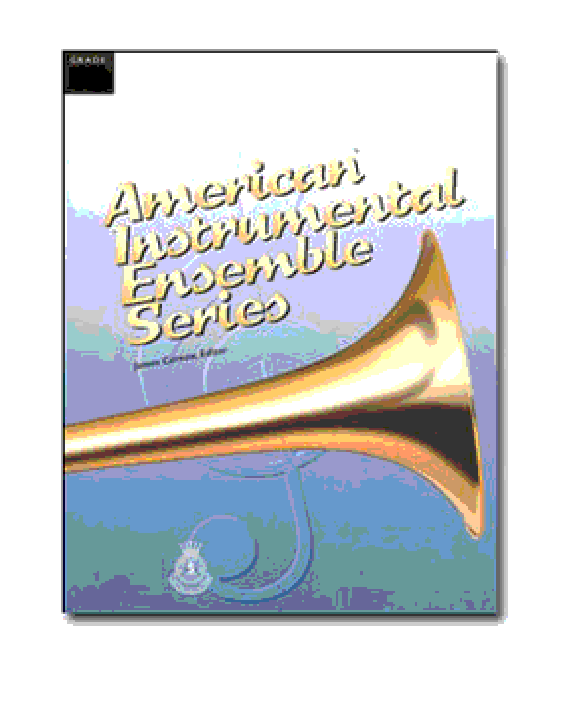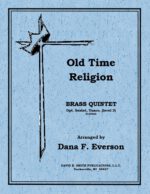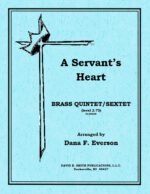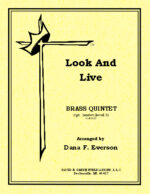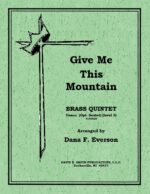| Instrument | |
|---|---|
| Level | 3 |
| Occasion | |
| Theme | There Is A Rdeemer |
| Writer | |
| Publisher | |
| Copyright | 2011 |
| Comments | There Is A Redeemer |
There Is A Redeemer
$24.95
Related products
-
A New Name In Glory
$9.00A brass quintet with opt. Trumpet for horn and baritone TC. It begins with fanfare motifs of the tune and then breaks into the hymn adding more parts as it progresses. It continues with a Q&A type of dialog between the lower, then upper voices. The second setion in a different key is reminiscent of the opening only this time in the middle voices and again moves in a Q&A type of dialog. Again modulating to a new key the theme is bounced around with rhythmical interest only to finalize in strong chordal patterns and ending on a bold declamation.
-
Meeting In The Air
$12.00A traditional brass quintet with opt. trumpet for horn and extra baritone for use as a sextet. The piece takes off immediately with a thematic statement in the trombone, breaking in a duet with the horn. Additional entries keep massing in the lower voices until most of the ensemble is involved. All of a sudden, the upper brass, silently present the tune in block harmonies until the lower brass present a countermelody. Now! Everybody’s involved. Next, a dialog between the upper brass and middle brass takes place as it alternates back and forth. With a modulation in place the tempo goes slow, the tune is in the lower brass- expressive! All of a sudden from bottom to top motives are presented- in stacked chords…. This goes through different transformations until the piece elevates into an uplifting conclusion.
-
Old Time Religion
$12.00A traditional brass quintet with an optional baritone part which allows to be a sextet as well. The beginning is active establishing a happy beginning to the piece. Then all the parts are in straight harmonies and then become fragmented. A modulation takes place allowing the lower voices to carry the tune. Then a tuba sola solo commences with light upper parts decorating the lines, until the parts fragment. This concludes with a modulation with motivic statements. After a brief intermission the piece takes off again with the tune in the lower voices and the trumpets add a flurry descants. As the piece comes to a close more and more voices add to the mix until the pieces adds a solid, grand statement.
-
Guide Me, O Thou Great Jehovah
$9.00A woodwind quintet with opt. parts for Alto Sax and Bass Clar. This piece presents itself with a sense of joy throughout with the introduction itself in a motivic manner setting the tone. The melody is fragmented, passing the tune around to the various voices. The middle section mirrors the introduction in texture and again passes melodic material around the different voices. The final section is more subdued until it starts stacking the motifically structured parts until it ascends to a dramatic conclusion.
-
A Servant’s Heart
$10.00A brass quintet, optionally sextet, begins with a soulful trombone solo joined with the remainder of the lower brass instrument only to be taken over by the trumpets. The middle section uses a punctuated accompaniment for nice variety only to migrate to the flowing style of the beginning. It then ends in solemn repose.
-
Look And Live
$12.00A traditional brass quintet with opt. trumpet for horn and extra baritone for use as a sextet. The introduction uses extraneous material where it leads in the first theme in the French horn, supplemented by trombone counterlines and trumpet flourishes. Thematic movies are then embellished leading up to a modulation where the tempo slows and a new mood encountered. The first trumpet carries the lead and offset with a horn duet line. Another modulation, an a-tempo with the theme in the low brass and accompaniment lines in the middle brass. This continues until the voices stack up until a boisterous conclusion is achieved.
-
Give Me This Mountain
$12.00A standard brass quintet with optional trumpet for horn. As one might expect the piece is cheerful from beginning to end. It opens with rhythmic patterns where the first statement of the tune is presented by the trombone. The chorus is harmonically in block format where it comes to an end. NOW, something different the second trumpet and tuba present a simple accompaniment while all the other voice, yes voices, sing the words and melody of the song! A brief conclusion, a modulations and the piece returns to the texture of the earlier statement. The a bit of tongue and check statements and a very conclusive ending.
-
Brighten The Corner Where You Are
$12.00A standard brass quintet with optional trumpet for horn. As one might expect the piece is cheerful from beginning to end. After a bright intro, the trumpet carry the tune until handed over to the middle voices with flourishes in the trumpets. After a transition that leads upward to an exciting climax. The piece abruptly shits to a quiet and expressive section lead by the trombone on the theme where it all builds to another zenith and once again abruptly goes quiet. A modulation and meter shift and the piece becomes countrapuntally gentle.. A meter shift back to the beginning and an exuberant building to a joyous conclusion.

